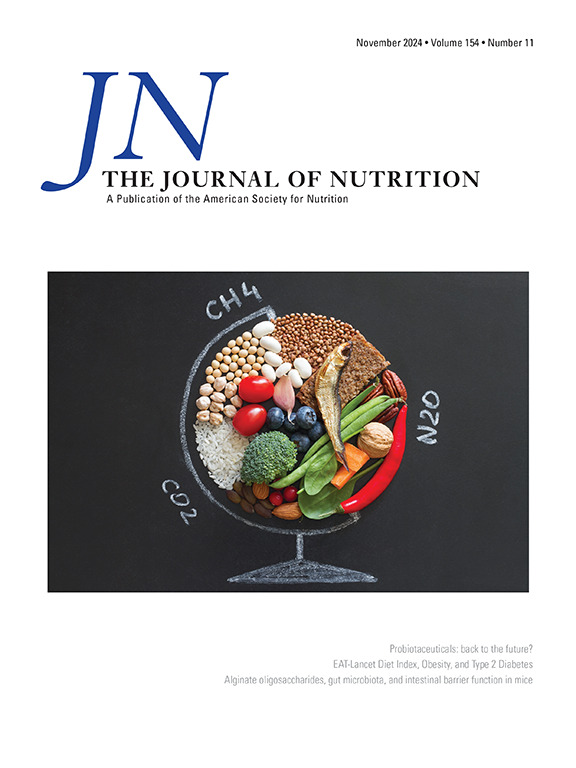Bioequivalence of Mulberry Fruit Extract and 1-Deoxynojirimycin for Postprandial Blood Glucose Lowering: A Randomized Trial in Humans
IF 3.7
3区 医学
Q2 NUTRITION & DIETETICS
引用次数: 0
Abstract
Background
Mulberry extracts can reduce postprandial blood glucose (PPG) and insulin (PPI) responses by slowing rates of glucose uptake following carbohydrate-rich meals. The presumed mechanism is the inhibition of intestinal alpha-glucosidase, mainly attributed to 1-deoxynojirimycin (DNJ) in the extracts. However, other components including other iminosugars or polyphenols might also contribute to these effects.
Objectives
The primary objective was to test the bioequivalence of a mulberry fruit extract (MFE) and an equal dose of the DNJ component alone, for reducing the PPG positive incremental area under the curve over 2 h (+iAUC2hr) following a carbohydrate-rich test meal. A secondary objective was to assess the efficacy of MFE and DNJ for reducing PPG and PPI relative to a placebo.
Methods
Healthy adults (n = 84) participated in a balanced-order, double-blind, placebo-controlled study assessing PPG and PPI following the addition of MFE (0.75 g, containing 2.90 mg DNJ), pure DNJ (2.90 mg) or placebo to rice meals containing 50 g available carbohydrate. Using United States Food and Drug Administration guidance, bioequivalence was determined by whether the 90% confidence interval (CI) of the ratio of the geometric means of the effects of DNJ compared with MFE was between 0.80 and 1.25.
Results
The ratio of the effect of DNJ relative to MFE was 0.903 (90% CI: 0.801, 1.019), meeting the prespecified criterion for bioequivalence. Although both MFE and DNJ produced absolute reductions in mean PPG and PPI relative to the control, these effects were more robust for MFE than DNJ. Mean plasma DNJ levels were also higher following MFE than DNJ.
Conclusions
This study confirms the bioequivalence of DNJ and MFE for reducing PPG responses in humans. However, although DNJ is largely responsible for this effect, other components of MFE, particularly 2-O-alpha-D-galactopyranosyl-deoxynojirimycin as a precursor of DNJ, may contribute to its observed efficacy for reducing PPG and PPI.
Trial registration number
This trial was prospectively registered at clinicaltrials.gov as NCT02599740 (https://clinicaltrials.gov/study/NCT02599740).
桑葚果实提取物和1-脱氧诺吉里霉素餐后降血糖的生物等效性:一项人类随机试验。
背景:桑葚提取物可以降低餐后血糖(PPG)和胰岛素(PPI)反应,通过减缓富含碳水化合物的膳食后的葡萄糖摄取速率。推测其机制是抑制肠道α -葡萄糖苷酶,主要归因于提取物中的1-脱氧诺吉里霉素(DNJ)。然而,其他成分,包括其他亚糖或多酚也可能有助于这些影响。目的:主要目的是测试桑葚果实提取物(MFE)和等剂量的DNJ成分单独的生物等效性,以减少富含碳水化合物的试验餐后2小时(+iAUC2hr)曲线下PPG阳性增量面积。次要目的是评估MFE和DNJ相对于安慰剂降低PPG和PPI的疗效。方法:84名健康成人(n=84)参加了一项平衡顺序、双盲、安慰剂对照研究,评估在含有50 g有效碳水化合物的米饭中加入MFE (0.75 g,含2.90 mg DNJ)、纯DNJ (2.90 mg)或安慰剂后的PPG和PPI。根据美国食品和药物管理局的指导,通过DNJ与MFE效果的几何平均值之比的90%置信区间(CI)是否在0.80 ~ 1.25之间来确定生物等效性。结果:DNJ与MFE效果之比为0.903 (90% CI 0.801 ~ 1.019),符合预先设定的生物等效性标准。虽然与对照组相比,MFE和DNJ均产生了平均PPG和PPI的绝对降低,但MFE的效果比DNJ更明显。MFE患者血浆DNJ水平也高于DNJ水平。结论:本研究证实了DNJ和MFE在降低人体PPG反应方面的生物等效性。然而,虽然DNJ在很大程度上是造成这种效果的原因,但MFE的其他成分,特别是作为DNJ前体的2- o - α -d -半乳糖吡喃基脱氧诺吉霉素,可能有助于其观察到的降低PPG和PPI的功效。试验注册:该试验在clinicaltrials.gov上前瞻性注册,标识符为NCT02599740 https://clinicaltrials.gov/study/NCT02599740。
本文章由计算机程序翻译,如有差异,请以英文原文为准。
求助全文
约1分钟内获得全文
求助全文
来源期刊

Journal of Nutrition
医学-营养学
CiteScore
7.60
自引率
4.80%
发文量
260
审稿时长
39 days
期刊介绍:
The Journal of Nutrition (JN/J Nutr) publishes peer-reviewed original research papers covering all aspects of experimental nutrition in humans and other animal species; special articles such as reviews and biographies of prominent nutrition scientists; and issues, opinions, and commentaries on controversial issues in nutrition. Supplements are frequently published to provide extended discussion of topics of special interest.
 求助内容:
求助内容: 应助结果提醒方式:
应助结果提醒方式:


